|


| |
|
Nymphs

Nymphs by Association
- the well-known (and more obscure) groups of Nymphs: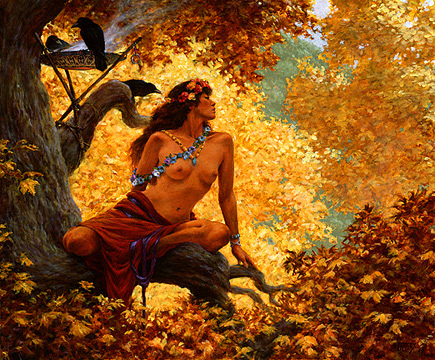
- Dryades
- The Dryades were the Nymphs of the Forest,
or wood nymphs. Dryades were immortal, unlike other types, like the
Hamadryades, who lived in oak trees and would die when the tree they lived
in died. They were the hunting companions of
Artemis. The
painting at left is by Richard Hescox.
-
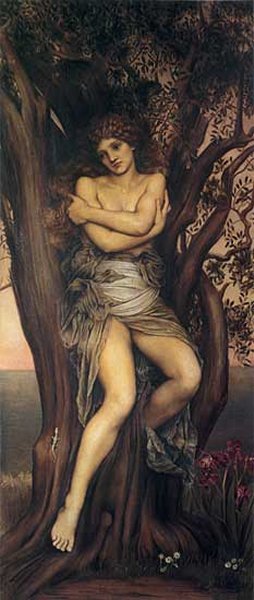
Epimeliades
- Epimeliades were the Protectors of Sheep.
So I suppose you could call them Sheep Nymphs.
- Hamadryades
- A Hamadryad was a nymph of an oak tree. She was
very connected to the tree in which she lived, and very powerful if
angered. If her tree was hurt, then the hamadryad was hurt. If her tree
was cut down, then the hamadryad also died. It was a hamadryad who began
the whole story of the Golden Fleece by punishing the son of a man who'd
thrown a knife into her tree.
-
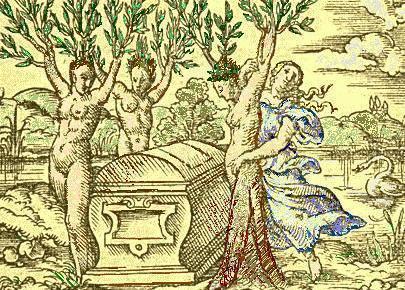 The
Heliades The
Heliades
- The Heliades were the sisters of Phaeton (son of
Apollo). Well, when Phaeton died on that fateful chariot ride, they wept
uncontrollably for four months. After that the gods took pity on them and
turned the maidens into poplar trees and changed their tears to amber.
- The Hespirides
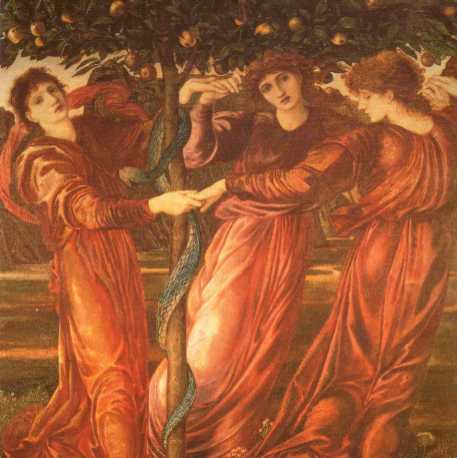
- The Hespirides were the nymphs who guarded the
Tree of the Golden Apples, as is shown in the painting at right by Edward
Burne-Jones. Their father was Hesperos, or the God of the Evening Star.
Their names were:
Hyades
These daughters of Atlas and Pleione were also
the sisters of Hyas, who died. They mourned for him so much that the Gods
hung them as stars in the Sky.
Lamusidean Nymphs
Lamusidean Nymphs were the daughters of Lamus.
They were the nurses of Dionysus, but because of
Hera's deep
jealousy they were driven mad. They would have chopped the baby Dionysus
up, and not Hermes appeared on the scene just in time to save the baby
God.
Maliades
These dryades lived in fruit trees - were fruit
trees ... ah, this is getting too confusing. Moving on.
Meliades
These dryades were the Nymphs of Ash Trees.
They were the daughters of Gaia and of Uranus' blood. For some reason they
are special, but I have not yet figured out why.
Naiades
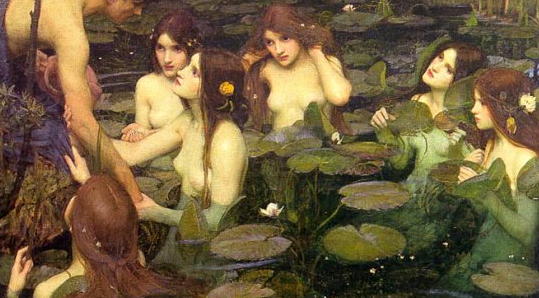 The Naiades were the nymphs of freshwater
streams rivers and lakes, but were not limited to these water courses.
Many Naiades could be found prancing around with Artemis, who chose 20
Naiades from Amnisus for companions. They were the daughters of rivergods.
They had extremely long lifetimes, but they were not considered immortal,
and were believed to have sat in on the Gods discussions on Olympus. There
were 5 types of Naiades:
The Naiades were the nymphs of freshwater
streams rivers and lakes, but were not limited to these water courses.
Many Naiades could be found prancing around with Artemis, who chose 20
Naiades from Amnisus for companions. They were the daughters of rivergods.
They had extremely long lifetimes, but they were not considered immortal,
and were believed to have sat in on the Gods discussions on Olympus. There
were 5 types of Naiades:
 | Pegaiai, the Nymphs of Springs
|
 | Krinaia, the Nymphs of Fountains
|
 | Potameides, the Nymphs of Rivers and
Streams |
 | Limnades or Limnatides, the Nymphs of Lakes
|
 | Eleionomai, the Nymphs of Marshes |
On the left is a detail from John W. Waterhouse's
painting of Hylas and the Nymphs. That particular story is
important to the Greeks as Hylas, the beautiful beloved (yes, in the
sexual way) of Heracles, was sent to go get water on the island of Mysia,
and the naiads there, totally taken in by his beauty, carried him off.
Every year, the priests marched to a neighboring mountain and called
Hylas's name three times. Someone will have to tell me if they still do
this.
Napaea
The Napaea were the Nymphs of the Valley.
In Greek nape means dell.
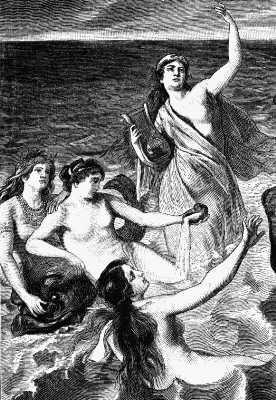 Nereides
The Nereides were the 50 daughters of Nereus
(the Sea) and
Doris. The were the
Nymphs of the Sea, and on the right is how one artist supposed
them. One of them was
Amphitrite. The
stories say that it was when they went and performed a dance on the island
of Naxos that Poseidon decided to claim Amphitrite as his bride. There is
a list of the Nereides being formed
here. Nereides
The Nereides were the 50 daughters of Nereus
(the Sea) and
Doris. The were the
Nymphs of the Sea, and on the right is how one artist supposed
them. One of them was
Amphitrite. The
stories say that it was when they went and performed a dance on the island
of Naxos that Poseidon decided to claim Amphitrite as his bride. There is
a list of the Nereides being formed
here.
Oceanides
There were 3000 Oceanides, and they were all the
Nymphs of the Ocean. Their mother was the Titaness
Tethys and their
father the Titan Oceanus.
Oreades
Oreades were the Nymphs of the Mountains.

The Pleiades
There were seven Pleiades, and you can find them
when you look in the sky (they are stars). Their names were:
 | Maia, "Mother" "Nurse"
|
 | Alcyone, "Queen who wards off evil
[storms]" |
 | Electra, "Amber" "Shining" "Bright"
|
 | CelŠno, "Swarthy"
|
 | Taygeta, "Long-necked"
|
 | Sterope or Asterope,
"Lightening" "Twinkling" "Sun-face"
|
 | Merope "Eloquent" "Mortal" "Bee-eater" |
They were the daughters of Pleione (an Oceanid)
and Atlas. Pleione means "sailing queen" and so her daughters would be the
"sailing ones", but the root could also be peleiades which means a
flock of doves and fits perfectly. They waited on Artemis with their
half-sisters the
Hyades and with
them were called the Atalantides, Dodonides, and Nysiades. They were
pursued by Orion for seven years, and got away only when Zeus granted
their prayers and changed them into doves. The picture on the right is an
engraving by F. E. Fillebrown. If you want to know more about the
individual Pleiades, there is more on some of them
below.
Nymphs by Name
- the nymphs interesting enough to say something about:
- Acantha
- Acantha was another beautiful nymph with the
misfortune to be loved by someone she didn't love back. Apollo was the
culprit in this case. He "loved" the nymph so much he tried to rape her.
The nymph fought back, scratching the Sun God's face. As a result, the
little nymph was transformed into the acanthus tree, a "sun-loving" but
thorny plant.
- Adamanthaea
- She was the nurse, in Crete, who took care of
Zeus and hung his cradle from a tree so that he wasn't in the sea, the
earth, or Heaven.
- Aegina
- This was the daughter of Asopus, a river god,
and Metope (she had TONS of siblings). She was abducted by Zeus, as it
every nymph eventually is, it seems, and carried off to the island of
Attica (which was renamed after her for a period). There she had a son,
Aeacus, and he became the monarch of the island. To make love to her, Zeus
changed into a flame of fire. Later, she became a lover of Actor's and had
three children by him.
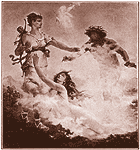
- Arethusa
- Arethusa was one of the many water nymphs who
attended Artemis. As one of the Virgin Goddesses followers, she had no
interest in men. So when the river-god Alpheus pursued her, Artemis helped
her out by turning her into a fountain. Alpheus, however, would not be
denied, and changed himself to flow underground so that he could touch
her.
- Agamede
- Agamede was the mother of Actor by Poseidon. She
was one of the first to use herbs in healing.
- Britomartis
- In a Hymn to Artemis, Britomartis is described
as the nymph Artemis loves best. She is the fawn-slaying, sharpshooting
nymph of Gortyn here, but originally she was a Cretan goddess who was
adopted by the Artemis cult. Anyway, the story goes that Minos, madly in
love with her, chased her all over Crete. She hid in oaks and marshes, but
couldn't shake him. Nine months he chased her without relenting until at
last he cornered her on a cliff. She leapt off, and was caught by a
fishing net and was called, from then on the Lady of the Net.
-
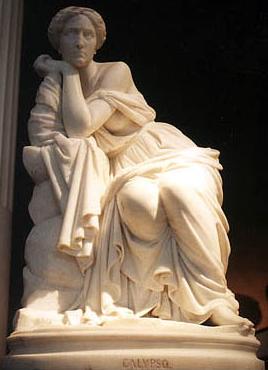
Calypso
- I started off liking her, but now I just think
that she's a bore. She was the daughter of Atlas. She is in the story of
Odysseus. She takes a fancy to him, and keeps him prisoner for seven
years, during which time they sleep together, although Odysseus remains
loyal to
Penelope (which I
don't understand), and eventually Zeus orders her to set him free. She is
also in the
Minor Goddesses section,
because she was a goddess as well as a nymph.
- Chelone
- This poor nymph got turned into a turtle because
she refused to attend the wedding of
Hera and Zeus. The
gods condemned her to eternal silence because of her insulting words.
- Clymene
- Clymene was but a simple Oceanid, but for a
simple Oceanid, she had a lot going on. She was the wife of the Titan
Iapetus, and by him bore Atlas, Epimetheus, Prometheus, and Menoetius. In
another version, she was the wife of Helios and the mother of Phaeton (who
is generally accepted as Apollo's offspring, but oh well). In yet another
version she was the mother of Atalanta. Some other sources say that she
was the granddaughter of King Minos of Crete and mother of Palamedes. Her
name means Famous Might, which is an interesting name for a Oceanid.
She's interesting.
- Clytie
- Also known as Clytia, this Oceanid was the
beloved of Apollo. Well, she was until he got tired of her. Then he
dropped her and broke her heart. She was changed into a sunflower with her
face to the sun. There is a longer (and better, if I do say so myself)
story about her coming in the Myth section. So stay tuned.
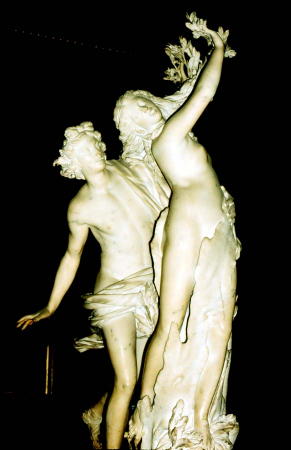
- Daphne
- Daphne was the unfortunate
Naiad
pursued by Apollo. Apollo wouldn't leave her alone, despite her obvious
aversion to him. She ran to her father, a river god, and begged for help.
Her father did the only thing he could do and transformed her. Just as
Apollo would have caught her Daphne grew bark and transformed into a
laurel tree. But the God still wouldn't let her be and plucked some of her
branches and made them into a wreath, saying she would be his sacred tree.
Poor kid.
-
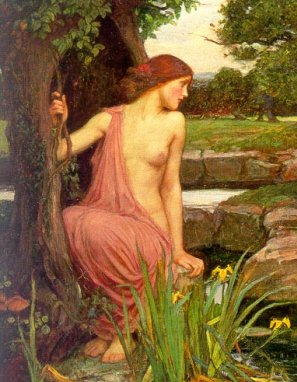
Echo
- Echo is probably the most famous of all the
nymphs. Her name and her voice live on to this day. She was the nymph who
had a fling with Zeus and lost her voice when she tried to protect her
lover from Hera's vengeance. Then she fell in love with Narcissus. If you
are interested in the story,
check out the long (and good) version in the Myth Pages.
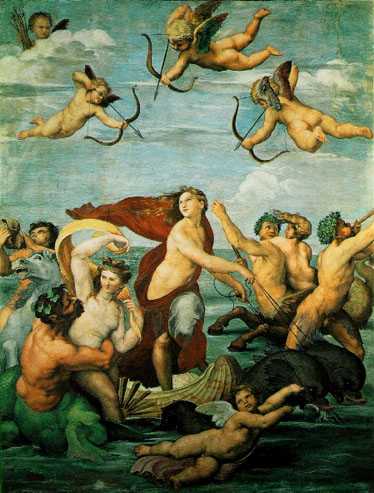
- Galatea
- Galatea was a Nereid loved by the Cyclop
Polyphemus (you know, the stupid one from the Odyssey). This could
be bad enough on its own, but matters were complicated because she loved a
human named Acis. Acis was murdered by Polyphemus and then one of three
things happened. Either she threw herself into the ocean and drowned (odd,
being a Nereid), wept so much she was turned into a always-flowing
fountain, or accepted Polyphemus and had a child named Galates by him.
- Lethe
- Lethe was another
Naiad, but her
river was in the Underworld. The Lethe was the river of Forgetfulness
and Oblivion. Lethe was a daughter of Eris.
 Maia Maia
- Maia, who was sort of a Goddess, has more
written about her in the
Minor Goddesses
section. But, to make a long story short, she slept with Zeus and bore the
Messenger God Hermes. She was also one of the Pleiades.
- Nephele
- Nephele was a nymph who was the first wife of
Athamas, King of Orchomenus. He dropped her for this human chica,
Ino. She was very bitter and complained
to Hera, after which this whole drama ensued. She was the mother of
Phrixes and
Helle, who she had
to protect from Ino, their stepmother.
- Oenone
- Called Oenone in Latin, this
Naiad
was the daughter of the rivergod Kebren. She was a Phrigian nymph who
lived during the Trojan War. Now, there are two stories. She was abducted
by Paris (yes, you DEFINTELY should know who Paris is) and became his
first wife. Later, when he died, she hung herself. Apollodorus, however,
says she married Alexandros and bore his son, Corythus. She had learned to
prophesy from Rhea, and tried to convince her husband that he would be
mortally wounded in Troy, but only she would be able to heal him. He
ignored her, and was indeed mortally wounded. Oinone was pissed, and had
no interest in helping him. Upon her summoning she refused to heal him,
but later changed her mind and hurried to Troy. By the time she got there
it was too late and so she threw herself on his funeral pyre. Either way,
she kills herself.
- Orphne
- Orphne was a nymph who lived in the Underworld.
But though she chilled with
Persephone, her
hubby (Acheron, the ferry-man of the Dead) worked above ground (sort of).
- Pallas
- Pallas, according to Apollodorus, was the
childhood playmate of
Athena. She was a
Naiad,
the daughter of the rivergod Triton, and both she and Athena were raised
to love to fight. One time when they were dueling, Zeus mischievously held
up the aegis. Pallas looked away for only a moment, but that was enough,
and she fell and died. Athena was distraught, and made a wooden statue of
her friend placing the aegis on its breast.
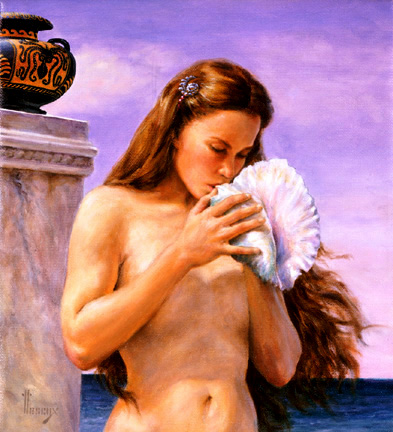 Rhodus Rhodus
- Rhodus was a nymph who was a daughter of
Poseidon. I believe she was also called Rhode. She was the mother of the
Heliadae with Helios. The island she lived on was named after her: Rhodes.
Eventually the island became the home of the Pillars of Heracles and a
certain very cool person named Ramsi.
- Rhodope
- Rhodope was a nymph from Thrace whose
intelligence-impaired-if-enthusiastic husband compared himself and Rhodope
to Zeus and
Hera. I think this
stupidity must have been based from the fact that he was the son of the
King of Thrace (the husband's name was Haemus). Anyway, the gods were not
having that, so they changed the couple into a mountain range with the
same names. Rhodope into the mountain range now called Despoto, and her
husband into the Balkan mountain range.
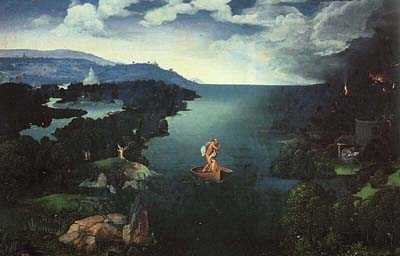
- Styx
- Styx was a
Naiad. Her name
meant literally Hateful. This may have been because her river was
the one that all of the dead must pass. Her river was the most holy and
sacred, and to swear on it was the most holy oath a God could make. There
is more to say about her, but you will have to wait for more of the
Myth Pages to come
out. The painting on the right is called Crossing the Styx.
-
 Syrinx Syrinx
- Syrinx is the nymph who was pursued by Pan who,
to escape him, begged the gods to save her. They took pity and turned her
into reeds. Pan, following Apollo's lead, cut some of the reeds in
different sizes and made a set of pipes, called the pan pipes from then
on.
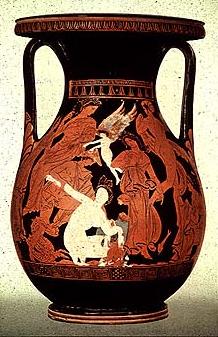
- Thetis
- Thetis was the chief
Nereid for a long
time, and it was she who found the baby Hephaestos and nursed him back to
health after he was thrown from Olympus (if you don't get it, check out
the
Myth Pages). Zeus
wanted her for his lover, but she rejected him (good for her!). Then, the
Goddess
Themis prophesied
that she would bear a son mightier than his father. Hearing that, Zeus
stopped being horny and started being scared, and immediately decreed that
she could only marry a mortal. She did, and ended up becoming wife to
Peleus, and mother of Achilles. As his mother, she tried to make him
invincible. There are two versions of what she did, and why she missed his
heel.
 


|
|

 Nereides
Nereides

















